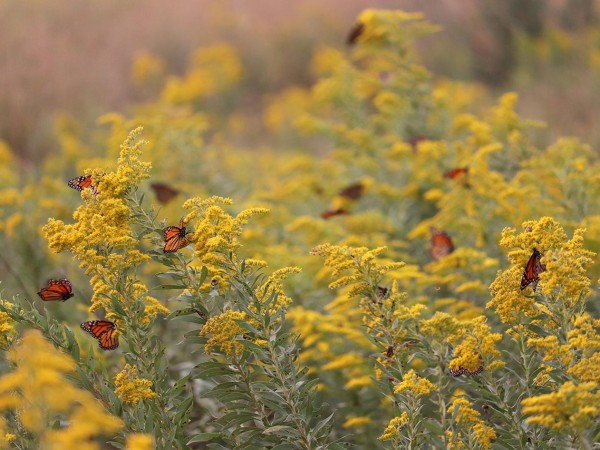Eastern Monarch Fall 2023 Report #1
Roosting Activity
A roost may have a handful of butterflies or more than you can count. Fall roost reports should reflect the number of monarchs observed within a roost for a single night. Please report every evening when roosting monarchs are present.
Thomas in Bement, IL reports: "First evening that I noticed some visitors settling in for the night. Counted ten total Monarchs; all roosting individually in three different silver maple trees. All were between eight and twelve feet off the ground and were located mostly on south and west-facing branches. Noticed the first a little after 6:00 p.m., with the last one coming in at 7:05 p.m. Sunset was at 7:11 p.m. Weather today was excellent with sunny skies and variable-to-light winds. High was 81F after a low of 51F and daytime relative humidity levels dropped to around 35%. Dewpoint was around 50 and barometric pressure was around 1020mb. Decent chances of rain in the forecast for tomorrow afternoon and night." (09/10/2023)
Darlene in Point Pelee National Park, ON reports: "Approximately 52 monarchs seen 6:20-7:45pm before 7:46 sunset at Tip at Point Pelee National Park. No monarchs seen below tower nectaring on the plentiful flowers. Walking south down west path observed monarchs fly in north from the west shoreline & toward Tip shuttle stop. Observed same on walk back up & one settled into a fall webworm eaten walnut tree. 7:25 back up at the shuttle stop monarchs started to show interest in settling in & establishing a cluster. 7:35 a cluster of three was located on bare vines in front of where shuttle stops. Others were individually settled on vines & on Hackberry trees. By 7:40 all activity stopped. Mostly cloudy & 21°c. North wind most of the day changed late afternoon to SSE & a light 8kmh. The lake was like glass. Daytime high 23°c. Overnight low 18° with rain in the forecast. Most appeared pristine." (09/11/2023)
Peak Migration Hot Spots
Peak migration events are occurring in similar locations to roosts, along the Great Lakes. Other peak migration hot spots are along the mid-Atlantic coastal region. People often report seeing large numbers of monarchs flying in a clear “directional” flight or seeing “hundreds of butterflies” nectaring in a field of flowers fueling up for the long flight. If you witness what seems to be a large number of monarchs for your area (i.e. dozens, hundreds), please report this sighting under PEAK Migration.
Brian in Ajax, ON: "Saw 214, all nectaring near Lake Ontario shoreline wildflower gardens. Counted over 2km walk in 25 minutes from 8:50AM to 9:15 AM. Sunny and 16C rising to 17C over the period, almost no wind, 3 Km/hr NE" (09/11/2023)
Betty in Toronto, ON: ". . . About 300 flyover. Monarchs were mainly coming from the east. A few from a westerly direction and the north The westerly could have flown over and decided to return to check out a food source. The majority were in pristine condition. 33 females. 87 males. Temperature 19-20 degrees C. Wind from East at 10 km" (09/11/2023)
Adults, Eggs, Larvae, and Chrysalises
Many observers also are reporting about all monarch life stages and milkweed presence in their areas. Mating and egg laying is still happening in some locations. Please continue to report these observations throughout the fall season.



